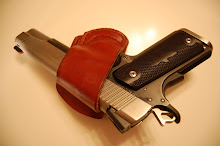So when you grab the range bag and head out ask yourself - what am I going to work on today? You might even take a notepad, write your goal and track your progress.
Today I worked on my draw and initial shot. Seems I'm very slow and sometimes inaccurate. If I'm going to be slow I should at least hit what I'm aiming at. So I stole a target idea from one of
 Todd Green's drills in order to force myself to be accurate while working on being smooth. The target is just an IDPA silhouette with a 3x5 head shot area and just the down zero counting.
Todd Green's drills in order to force myself to be accurate while working on being smooth. The target is just an IDPA silhouette with a 3x5 head shot area and just the down zero counting.I fired one shot strings, five to a series, of draw, fire and analyze. If at any point before the shot I didn't do it right, I'd stop and start again. No point in rewarding bad behavior with a bang. By working back and forth between the smaller head shot and the larger circle on each series I was forced to adjust speed to meet the accuracy requirements. At the same time you can push a little more each shot until you exceed your limit. By the end of 50 rounds I'd seen a consistent improvement in my shot placement and times.
Now a lot of the top shooters we see at our matches don't think much about burning through 50 rounds but some of you may be more restricted with your budgets. Today's practice lent itself to
 using a .22 conversion kit. Taking away much of the noise and recoil lets you focus on what you're working on. And in the case of single shot draw drills (say that 3 times fast) the break of the first shot should be the same whether you're letting loose with a .22 or .44 magnum. I use a Kimber kit on my 1911's but most major brands have a conversion available either from the factory or third party for whatever you shoot. Or you can always buy a dedicated .22 that mimics the feel of your full-size gun.
using a .22 conversion kit. Taking away much of the noise and recoil lets you focus on what you're working on. And in the case of single shot draw drills (say that 3 times fast) the break of the first shot should be the same whether you're letting loose with a .22 or .44 magnum. I use a Kimber kit on my 1911's but most major brands have a conversion available either from the factory or third party for whatever you shoot. Or you can always buy a dedicated .22 that mimics the feel of your full-size gun.I've found that starting without a timer and concentrating on the point of your session, then progressing to using the timer to measure your performance and progress seems to work best for me. After a while you can feel whether a particular sequence was good or not, but it's amazing how the timer keeps you honest.
And one more thing... the first string I shoot in a practice session is usually a "street drill" with my gun as carried. Factory ammo and something typical of a self-defense situation. I've been using the F.A.S.T. drill lately. It's a check that your equipment functions as carried and what your likely response times will look like when you're not all warmed up and tuned in. Talk about a dose of reality!
Make your practice count, enjoy the time spent burning powder and see you on the range.

Practice! Why would we do that?
ReplyDelete